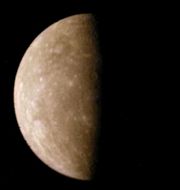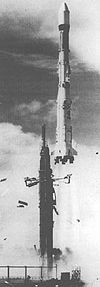BepiColombo
| Organization | European Space Agency, Japan Aerospace Exploration Agency |
|---|---|
| Major contractors | EADS Astrium is Prime-Contractor for ESA modules. |
| Mission type | Orbiter |
| Flyby of | Moon, Earth, Venus, and Mercury |
| Satellite of | Mercury |
| Orbital insertion date | June 4, 2019 |
| Launch date | August, 2013 |
| Launch vehicle | Soyuz 2-1B/Fregat-M from Kourou |
| NSSDC ID | BEPICLMBO |
| Home page | BepiColombo Home |
| Power | 5.5 kW available at 1 AU |
| Orbital elements | |
| Orbital period | 2.3 h (MPO) |
| Apoapsis | 1508 km (MPO) |
| Periapsis | 400 km (MPO) |
BepiColombo is a joint Cornerstone mission of the European Space Agency (ESA) and the Japan Aerospace Exploration Agency (JAXA) to the planet Mercury.[1] The mission is still in the planning stages so changes to the current description are likely over the next few years. Due to budgetary constraints and technological difficulties, the lander portion of the mission, the Mercury Surface Element (MSE) was cancelled.
Contents |
Mission
The mission as currently envisioned involves three components: the Mercury Transfer Module (MTM) built by ESA, the Mercury Planetary Orbiter (MPO) built by ESA and the Mercury Magnetospheric Orbiter (MMO) built by JAXA (whose sunshield (MOSIF) will be built by ESA). The prime contractor for ESA is EADS Astrium.[2]. The three components are planned to be launched together on a Soyuz-Fregat launch vehicle in August 2013. The spacecraft will have a six year interplanetary cruise to Mercury using solar-electric propulsion and gravity assists from the Moon, Earth, Venus and eventual gravity capture at Mercury.
Arriving in Mercury orbit in August 2019, the spacecraft will have a 1-year nominal scientific life. The MPO will be equipped with eleven scientific instruments provided by various European countries including visible imagers, a laser altimeter and an imaging X-ray spectrometer. Russia will provide a gamma ray and neutron spectrometer. It will attempt to map the entire surface in several different wavelengths, and to find water ice in polar craters which are permanently in shadow from the sun's rays.
Mercury Transfer Module
The Mercury Transfer Module is at the base of the 'stack' and provides propulsion to escape Earth and to approach Mercury. It carries no significant scientific instruments.
Mercury Planetary Orbiter (MPO)
The Mercury Planetary Orbiter will be a 357 kg spacecraft in the shape of a flat prism with three short sides slanted at 20 degrees covered with solar cells providing 420 W at perihelion. A radiator with an area of 1.5 square meters is mounted on one side to provide thermal control. The radiator is always pointed away from the Sun and is protected from planetary IR with a 3.4 square meter shield. High efficiency insulation is also used. A 1.5 m diameter high gain antenna is mounted on a short boom on the zenith side of the spacecraft. The MPO will be 3-axis stabilized and nadir pointing with a planned lifetime of over 1 year in Mercury orbit. Communications will be on the X/Ka band with an average bit rate of 50 kbit/s and a total data volume of 1550 Gb/year. A UHF dipole antenna mounted on the nadir side will be used for possible communications with the MSE. Navigation knowledge is provided by 3 star sensors.
The MPO will carry an imaging system consisting of a wide-angle and narrow angle camera, an infrared spectrometer, an ultraviolet spectrometer, gamm, X-ray, and neutron spectrometers, a laser altimeter, an ion and neutral spectrometer, a Near Earth Object telescope and detection system, and radio science experiments.
ESA has selected Astrium as the prime contractor for the construction of the MPO.[3]
Mercury Magnetospheric Orbiter (MMO)
The Mercury Magnetospheric Orbiter has the shape of a flat cylinder with a mass of 165 kg (364 lb).[4] The MMO is spin stabilized at 15 rpm with the spin axis perpendicular to the equator of Mercury. The top and bottom of the cylinder act as radiators with louvers for active temperature control. The side is covered with solar cells which provide 185 W and second surface mirrors and protected by thermal blankets. Communications with Earth are maintained through a despun 1-meter diameter high-gain offset antenna and two medium-gain antennas operating in the X-band. Telemetry will return 160 Gb of data per year at about 5 kbit/s over the lifetime of the craft, which is expected to be greater than one year. A microstrip UHF patch antenna will be used for communication with the MSE. The reaction and control system is based on cold gas thrusters. Deployable booms and wire antennas are stowed until orbit is achieved. The MMO will carry a set of fluxgate magnetometers, charged particle detectors, a wave receiver, a positive ion emitter, and an imaging system.
Mercury Surface Element (MSE)
The Mercury Surface Element has been cancelled due to budgetary constraints.
At the time of cancellation, MSE was meant to be a small (44 kg) lander designed to operate for about one week on the surface of Mercury. Shaped as a 0.9 m diameter disc, it was designed to land at a latitude of 85 degrees near the terminator region. Following the release of the MMO, a burn of the 4 kN thruster would put the MSE into a 10 km orbit. Another braking maneuver controlled by gyros/accelerometers and an optical range/range-rate sensor would bring the MSE to zero velocity at an altitude of 120 meters at which point the propulsion unit would be ejected, the airbags inflated, and the module would fall to the surface with a maximum impact velocity of 30 m/s. If the landing occurs in sunlight a thermal protection cover would deploy. Since 40% of the terrain at the landing point would be in shadow, primary power would be supplied by a 1.7 kWh battery. Scientific data would be stored onboard and relayed via a cross-dipole UHF antenna to either the MPO or MMO at a data rate of 8.7 kbit/s, providing for a total of 75 Mb over 7 days, assuming 18 contact periods of 480 seconds each. The MSE would carry a 7 kg payload consisting of an imaging system (a descent camera and a surface camera), a heat flow and physical properties package, an alpha particle X-ray spectrometer, a magnetometer, a seismometer, a soil penetrating device (mole), and a micro-rover.
Propulsion
The MTM (Mercury Transfer Module) will utilise two propulsion systems. A standard CPS (Chemical Propulsion System) which is bipropellant using MMH/MON3. The CPS will be utilised for Earth escape and the Lunar fly-by. Post-Lunar escape the CPS will be pyrotechnically isolated and function in blowdown mode for the cruise, only utilising the AOCS. The spacecraft will be propelled in cruise by a form of ion drive dubbed solar electric propulsion, which has a very high specific impulse and very low thrust. Unlike a chemical rocket which fires for a few seconds, it will keep propelling the craft for years, building up far more speed per mass of fuel in the long run. This will be the ESA's first mission outside the Earth-Moon system using such a form of propulsion. Bepi Colombo is also the largest solar electric mission so far planned.
This drive will be tested by the unusual need to actually push against the direction of travel, instead of with it; the ship will be falling toward the sun, accelerated by its gravity, and will have to constantly fight to keep its velocity slow enough to eventually enter Mercury's orbit.
Namesake
BepiColombo is named for Giuseppe (Bepi) Colombo (1920-1984), scientist, mathematician and engineer at the University of Padua, Italy, who developed the gravity-assist maneuver commonly used by planetary probes today. He helped NASA to devise the trajectory of Mariner 10, the only spacecraft to encounter Mercury during the twentieth century, exploiting this maneuver for the first time around Venus.
See also
- MESSENGER
- Mariner 10
References
- ↑ Amos, Jonathan (2008-01-18). "European probe aims for Mercury" (web). The European Space Agency (Esa) has signed an industrial contract to build a probe to send to the planet Mercury.. BBC News. Retrieved on 2008-01-21.
- ↑ "BepiColombo To Enter Implementation Phase". ESA.
- ↑ "BepiColombo To Enter Implementation Phase". ESA.
- ↑ H. Yamakawa, H. Ogawa, Y. Kasaba, H. Hayakawa, T. Mukai, M. Adachi (2004). "Current status of the BepiColombo/MMO spacecraft design". Advances in Space Research 33: 2133–2141. doi:.
External links
- ESA site
- BepiColombo page at ESA Spacecraft Operations
- BepiColombo Mission Profile by NASA's Solar System Exploration
- http://nssdc.gsfc.nasa.gov/database/MasterCatalog?sc=BEPICLMBO
|
|||||||||||||||||||||||||||||
|
||||||||||||||
|
||||||||||||||||||||||||||||||||||||

